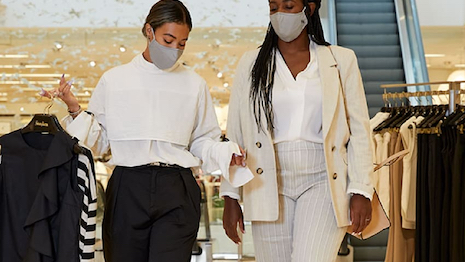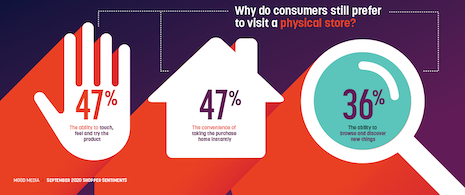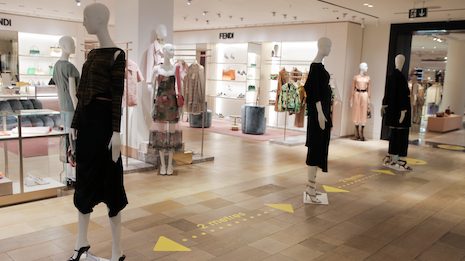As a growing number of consumers are comfortable returning to in-store shopping as coronavirus lockdowns lift, some shopping behaviors have changed — but it is too soon to know which habits will, if ever, return to pre-pandemic norms.
According to a new study from Mood Media, 71 percent of shoppers are comfortable returning to bricks-and-mortar stores, with two-thirds of global consumers having already returned to non-essential stores. However, about three in 10 consumers report they are spending less money and less time in-store than they did prior to the pandemic.
“One of the most surprising findings is how many shoppers globally have already ventured back into non-essential stores,” said Scott Moore, global chief marketing officer of Mood Media. “While many have reservations about the safety of doing so, it’s clear that they're slowly going back into retail stores regardless.”
In partnership with Censuswide, Mood Media surveyed more than 8,000 consumers from the United States, United Kingdom, China and France.
Time is money
Although 49 percent of consumers worldwide are concerned about catching the coronavirus while in-store shopping, 80 percent are comfortable with the safety measures retailers have put in place.
Mask requirements — which have been put in place by the majority of luxury retailers — were cited as the most important safety regulation. Only 8 percent of consumers reported that safety measures have negatively impacted their in-store experiences.
 Shoppers and staff are required to wear face masks in Neiman Marcus stores. Image credit: Neiman Marcus
Shoppers and staff are required to wear face masks in Neiman Marcus stores. Image credit: Neiman Marcus
While 67 percent of all respondents reported that they have resumed in-person, non-essential shopping, many consumers remain weary.
Non-essential shopping rates vary across demographics, including age and location. Seventy-seven perfect of shoppers between 16 and 24 years old are comfortable returning to stores, compared to 64 percent of consumers 55 and older.
Twenty percent of consumers, including 27 percent of millennials, also cite finances as a reason for not returning to non-essential shopping. Nearly four in 10, 38 percent, reported doing all of their shopping online as a reason for avoiding in-store, non-essential shopping.
Among those who have returned to physical stores, 31 percent are spending less money and speeding through shopping trips. Globally, 21 percent are spending the same amount of money in less time shopping, while a quarter of Chinese shoppers are spending more money and less time in-store.
Only 3 percent report spending more money and more time in-store.
“Another interesting insight is the volume of shoppers who are practicing ‘mission shopping’ behavior, meaning they're trying to stay focused on exactly what they want or need to get in and out as quickly as possible,” Mr. Moore said. “Very few consumers are slowing down to browse and discover new things right now, even though they still cite this aspect of shopping as one of their favorite things about bricks-and-mortar.”
The in-store shopping experience remains valuable for consumers, particularly sensorially.
 The in-store sensorial experience remains crucial. Image courtesy of Mood Media
The in-store sensorial experience remains crucial. Image courtesy of Mood Media
Nearly half, 47 percent, of consumers are opting to shop in physical stores because of the ability to touch, feel and try the product in-person. However, in light of the pandemic, many retailers have introduced enhance disinfecting procedures or limited dressing room capacity.
Shoppers also prefer to visit bricks-and-mortar stores because of the convenience of bringing purchases home the same day, as well as the ability to browse items.
“Luxury retailers should re-examine their merchandising displays, signage and selling techniques to facilitate the mission shoppers as they work to get in and out quickly,” Mr. Moore said. “This will in turn drive greater appreciation and customer loyalty.”
U.S. shopping attitudes
Though these findings may be encouraging to luxury brands that had been investing heavily in upscale in-store experiences, it is notable that U.S. consumers are more resistant to physical shopping compared to consumers as a whole.
Sixty percent of U.S. shoppers have returned to non-essential stores, compared to 67 percent of consumers worldwide and 81 percent of Chinese consumers. U.S. shoppers between 16 and 24 years old have resumed non-essential shopping at a rate of 54 percent, compared to a combined rate of 74 percent of Generation Z consumers elsewhere.
Recently, researchers are finding correlations between in-store foot traffic spending and confirmed coronavirus cases in states across the U.S., which spiked throughout the summer.
Nationwide, there was a substantial decrease in foot traffic beginning in mid-March, with foot traffic hitting a low point in the U.S. in mid-April. Walk-ins were a mere 25.2 percent of last year’s numbers, per recent data shared by Zenreach, although things are beginning to bounce back a bit (see story).
Looking ahead, only 22 percent of U.S. shoppers expect their in-store shopping habits to “return to normal” by the end of 2020 — compared to 25.5 percent of global consumers. Only 10 percent of respondents worldwide think their pre-pandemic shopping habits will never return.
Now as the fourth quarter gets underway, the COVID-19 crisis continues to plague both retailers and consumers worldwide.
A weak Black Friday and holiday season would be dire for retailers after a prolonged period of store closures and poor sales.
Retailers should think about how to spread traffic out throughout the season to avoid the crowds. Earlier promotions could help extend the shopping season and could lead to fewer consumers showing up on each shopping day.
For luxury brands and department stores, sales could pick up as affluent consumers look to spoil themselves and their loved ones during the holiday, spending money on luxury items instead of travel and restaurants this year (see story).
“As luxury retailers oftentimes do so beautifully, they can explore ways to help their shoppers slow down and relax, while helping them feel safe and assured and giving them a little joy in their day,” Mood Media’s Mr. Moore said. “Everyone's looking for those little moments of delight right now and who better than luxury retailers to provide it.”
{"ct":"Y2NexA+i8NGP\/mkl5se6RNSsprf67i+3N80vMkSlUNR6kkrVv\/zAOPuAM0Vge+F28gC19p3IbuXR\/7YOh8rrAYrK4mwjSFmO4xW5UxUWpnG+z14Wx6UYnPuFsLgydUEstkxyD1F8TrnrMotahFEOMM\/NrJIXUDoZ5hfQXzNQF\/wZjKfYbszr8\/CWX17m4ganNUk1Ndtrc7m9G6icNBjmfIw9haQmGInsa9u69kJ+Mk\/8zdhcRvJzrlXBeKTD0atoSFaHtbU4iCVx641COv8vb4A5kpF5OMmRf+4uhP5KkULLD5+IkQx9Sl5Oa9nig8+WbjxyXmaiLq2nIXWleN6AW5RBAipJ\/SKFxxFjKDNcm69IheAudgz\/CSBaZ3pAj2HFUc9hK0Fb2gV55PtPqTvvJ3ey6b6NQp41+rcjOF7AP\/xfM5p9H4SRtNtC0GduNY8y+S8bnIy\/\/UiBMDSb51XAaQQC\/v6KWtoc7twDCCp2sqaIjLmLxEC6UWrwGfuTE6jEDOHNt3VkYnXeYB+ZfRMRm2eki0C3jU1fAfWYkMsPKgJXSK\/3OoGTYIUfkGY+tl0Ot8uxtvmagkGU\/t1qqQlwKyTqEqYqQBMVEK0C1aQLzACQ4iPJM8\/mnG1t14MD0Sw8b6htLefqu8ef3j4MfJw4F5aR5BXJu75Zb9c1EUsLBPtBjD+NvKvlDTEhB+xaNcvJktdhF\/mHhBgyeo3qomuKrTX5ngMppM12zds5mo2Z71ab9FlIhNwRteX\/6\/GJhHsuatSLCyF1QiJEA3ElkyPg57rBXgytgbsKlzwud8M182hf+Ve2yw4RUfICWwb+VovQmwfFphLi0fZqpZu9zdhHw4\/1MdnxmMw2c4W8qEREC0DC60V0zzP5o03BBNQ5VNdDjqF5JydeLcMDNS2nzq3Ln5Jhn8ZPBS\/ECb1pvR7h9NkqYNFjzV64ohybKXnwePJcs4ijYwEN4z3bmiH+0bs7p6Kmtdg8b0\/bidHazsoE1ohxir3hoSj2R58BYt7Z4MfQ68jVmFo7ND5F2U1hkwqbATn9lH4bIa1hhXW9Zmn+wXesHyt7C2EilFGN8Mmy5hwhw8zxBvc94hYZ2nGoKsW6cIEOHVgwVYBHLkf6e9x31HmGCB2qzcEGMztmyWjRyviFjmPLgBnkyRMMMP369zswjF4iChuq8M4Hyvb2v+XpORg3OVSyJp9rf0aZRpBslozig0YnbhBWbKTy15Za1cKbV+D0gD3NNHQUmqH4llgRdgwJUywwiGbMKAktvVQ79UzB29Yy4JROE4O1vwklStegd9EA0hJxHQAs8er4RvRFvUY3aGqyfcHpkjU9gJdIiQiEVNVW\/h0bDrruYy4xdQsaPM45WiZHdP3kPNh+mkBzleTy8VV24ipkDsJd2HlTH7rNEptlakbWSFkgmEgbGzGArtzdFmraG4yL1d\/WYfODQ6iupCRtInMbXdtYvilhOIEGTKK278cOqdNBvOSGfpCP0WMg+oHyeHTwxRqGyWhqEZWiTjtH\/lWZXFRFFCsglAL6sl8Thm0G3hccbICsm4xcgW2bP7aVs4O8gpnRgi24Xtn+Xsde2JnbXDmYbl1m94tsBqNBIPWMgKaOtU1mF5NgLppluL2mOhg4N75ZDsDy0o3Pc3TOewf+5OAcxHiHYKxDdXog5ebw5ZF5rLOd5AWY9KEYrSooCw9r6iUsl43gqQeTTFBvOOXfTpkE1TuFFrwLOUcndy8IDq67eIA3ObXqT1tJJmG7dpOqu9i8rANg0kEXMEzQ7EmX8BM+PonpwGfswm0uR\/IePm8wOzW3AxstyP1zHt7ulPwDt2XYnb5kUbrb93T45PhPyKpVm8b2I8waZjyJbqCO6ws1w\/WDEYwRFaTO\/aN\/ARzxuw19+YwlfRxgKQZamSZI36DxVshDHSk9gMSilq8wCC7Xa08yAZ1M4E+yhR8cekVMLjxm5GEb3bM3pjyJPLzKOfWjjRc+P2hvupacIxXF1eZ34VYLF17MkIRqDTnB1S1JPtKvTlAywKQYi329w5TGjwiY8LPRXTQwcAgydyOG5DDFd8iUyYgzjjEzqCYqMafvPiCbvaGCaFM\/mNSJWEifNKfpB2NyNTfTThrKi7h8gTb7adqwOETrnqasKgHs36dKRFMuIrO\/grXrDQVNlBXtOs3b4kV\/s7xvjuOtPX2\/OAKuYz50qFdnW2rWFNSwLg9zQA7RWjp4EH+cqhci9ZIZ3X5I+BIME4iJ5jywDk0RNCq+eeZGLn+OrNh9Uy9XAwmQo58op\/\/vp9Eyi\/bq2hmYG6it46uq4aYfybPwDVSBS6JiwMChL62hVLwQ0HTX0TqqW5ihIWrFpjT11IPR7RVLqs+Nb5Uo77bBAvCDIEvR3OfnDDgPkvSOqihrTMVLFB1SK292sZ2r3rMeAtjSThGzJCIhixHUVn2JMizN\/9ggKVBKfvCzrzmDQTN4ZADCZmiqkVRw85NF0yYdWlog5CC0CcmktN7Pbcv9AeICRlQ3XzzF0QuqCvd5mzIVoEGyAXMs47hY8ve5U4iqHucvNJk3yOSwFihAtcGr+Fm7dWeqKf5mj82WygWVmxO69h4GMaFK14UoC1F2gopeL5LN1usqJE5OAe+J3b6GEnhOJNbFqA5eTA3Shql55rYzu6f0OU1l9O9avD5A9dToECWXXXieX4y1PeA5E9UGF\/3BX+W51+GgFf+PsZNi5A+25HJCGl8dF1iDUnzn8qDXz0lhMyTbhTDuQtHtjS4UJy+GHZEn72P8V2RpHgslsdT3OTdmDZjWQOB\/zrlDcqX3DTIL4tOG3IfxpMA89uhlJpqgDdZrmsJHB93UsZzOzdQOFQ1HyUBvteavsBH2HXh6Gjfhi\/M\/pD+fHKuZm5zNywmiVHiprORTqS55a6Y9JVYt0jlBdXptkJZM\/HjgGSfxS4bekPsw7PIsrkUhjCw18ZxCsLjXezmskF3T7BpRboAxd+X7Sn6e1LjrpboYazPDw+QNslXa3EaGVHC6KKCEEm\/nsZiFS4oLcS2hhjeHC5uELdSnBICU9\/yIoQi3WCONcg3pL8Qud7XjvJkeXtyaV6vzUb9qEcTVTctA02r8T9O3vdk4DkhX5GMqo\/c9HZZf3ZXp+ifxOX\/tPdXLDVCM0lI+Ub+SrhHue0vfBEQ1Y8kZKRH1ULgK1iuDw7GA\/aQGMuJnfmaMd0KTjNT8saSGaWiz2fRJ+dGUpKXDFGocmXlFeolA6tFExohyynxHREtorS9pvHpDaYcs57o4\/M4Kg9i2gwlCxBMvSNy6qw1sWvttpmxZtAMHLS+nAHJG3mA0VwlYTSw3vfQfgG8I8xcZmS+7CVUZXTwEQ+L9sn4OAng6ShcP66aFRs6A9oEJJhDWXwycMG8MMAhpWg55PgMP6xopHOCqTeDHV3kF3QOb2xLC\/WcMru+tGqo3Y1VftIzYfFqrqwLnAkNSMB15wO6LggdPC0h\/vn3eX6l2pjVHh0xMHgvS4uSQDeoXLXBbVBZfdYPolqvG2CONAzgdMef72OP0UMW420pXoronc\/5PsY40S2u\/9n1OI9XFxh7MR3OmIc4egh2u3k4LZ4C5Za584CIqbALLcWSd74A1gGjK+rEOqOhb9Kiw7ItjIsKxI+C7Bi8rJ15SA8EFvDJfCQsMjI+5PUpCYW3V7RJWlptawpffys\/FMFFN9+eINEqGksml+cKijHmwWHvc7E+S99eAZXxRZsV77kXRnM2RGFuw0sJ\/UBdZc2GsK+LIC5KxhaBSn71Yr7Ls93TY03D9SRLP7Zb3\/OgzDNJPW8qmvmg8R0bMdNiuWB44W4cHNMoI3\/+dSORcoggvm6feJsSIgV7YF441NWh87OyqLiKBaoMyUDWH8W4Mc\/1anc\/jYT7B8Y95n5+g30Xu6Xx0IV3MxqihTH0Gpj5Izg3E5lASq6s\/+YTQnmT6IlBTHbld9eeys7FeuLnKQQc08QjE93TW6rwYDsqIYa+V841Ykntot0pZN5yGENxq939uRbckVUMvXcDXvyFqXdhzvhMLOaZ+1oj3gROlE7RE\/ZRLenQ1+3i0Y+8IItW0\/utK\/AuOZRFnOg+OTtpaTEgCmAevvu3wGBWoKNamAFQrbMjBmy9c7hf9IN3h7HwaGkUNKLDSH7rQUR0dwAMOpwpEt5EnqBq+NA\/4wNaNpQVqOkEhrsjd2lexx\/B5UVB7oGzWU+ofzE2790lZayJae8cgbHnckGh6C1YcvtgTqVfLygCcoTikRcuTJAoHqkDlnAuMocezkQCPEw7RmtmVRLlhgdSn+jiqG6MnsMt4Yrwp1b2JF\/IJYvau17VeQHlruVPpTttB91REqfkIwIJNyepm2MLY9egH9LGjB6q5Xyv+qSZE7OfgE\/qY0tvTbIiEmPOm6qEZR5ETDsIAasIEAWE119R4YtgQy48KBOVanpowVXZhl6zA8HCKhewOtcfTGs6xdxpbBmCKJB4ddEeXZiv+SrRQmTKofLEmUCCGB3Erbbu83Xvs3RPblSZCqEV1W1dFXScAYd5u5bCWkvt4AabLNccX4zi6\/oCOQ7FTMtzg7wolxn9rJYpGOCoY26+TwlU1edLW8BAnF7Vm9EeiKIcBjgMnY9K9r+WlXIbmwDWaq3O7vUoJ6whrVE7Bf54WkC1qKWKszEVs8qHbH52YlQ0PytINqI220rh8ByPBnKv\/K1MJc+pCgUFUibsf41juOlDFrKQG6MOUoiXPOAzpUgcJs1R1+45dCKGQ9S89t5mu6Sianb0Rl3RHPRxcG+OCv\/MmeZpPpatTfbShCOAphTFZlE+NFkQyLPNXMrUST7Yagp+hzYO82AXd3z9s9yWnhKrN8BtGAoVkOvAwtvwcGCwCTFR856V1Sp65maQaiuD1\/meZphv3clXRU0VM\/yWvUEI\/ojgMLi7FiQnprWWvLftwqWlm6to6PdpRXA9U\/VKxH73Dq\/S9XsBDzXdFmRU03XfDLf9V0UAeLCVPAOrPnwop6Ox1zs\/HVFJqGSgYwfieKBpyjuKOlKo\/r4N7k3l7GbK5hegIl0OQuk2U0WrSE2t80y+XTcYM0qzR0hGcMQ2DUngOxQcdbATfTwk0x9aQyWnVnYJnNr7MHP7t+MJ95K2RPDsOvCS2e1fOaUEWiIyF\/XPMRH6Rqp3kjq\/PdfFjhbJW5s0N1aickLu07WDfcQYVE6LIOMCvRggzbf0fOF83wgkyF+RSsyNonNzMEggnl2Y+yTjSJIBKbGw1C3HWbSSIxdvD1ZRxjHr4gXbSj\/YQtBLa2ISDHC5APUBfja3t8HN\/G6lsayvGl4lvdQsFB0+m08sRaCd4CJiG5pU31jEQYqiZtl44+f2mWEWqdmD9Pxo6PPhTU0\/5KfXk4o24oelvVl\/fm6YhIJEAoEkTbpWUR1jUubEC6LKfv5NRHNqD+hk217kjHAHpfdS9SqCp2ZamXJ0zZ95MqvCYW8VMqGH4tA1aiVZ6L3bNKddBn591CU39nYutI8wLdxxrfcjkej0u4tPNqZpTFrU1TSHmpBX6llvUw5pZwGL9A3qtWf20F8vHdzCizcLhgTwaqP2Q6jpRaOD0pK1kK\/qOj4\/u2s7ePjA40KyEajq2AuVPbQKgSV3Lnf3APprhTRxEArr0QlqB6GZpjXtQe9fOKw41e3z2qoAakfzLiaKiGCpGy70YZYvOXIv+RID3yxQn0IPHpobe35t5m3reOYR8gKlYhAqyQdLjD1oj3Y4lCRQqKtvs4FfhiSrPZqq4UIAePc3WyBP82YUS3nhKiVLbeLvb9LnNKksqonn+\/ooJS3jdyiCScXuQcp0OETAB8AfMRT58BanNsKgPJQZX24YeDUC\/1+qWWX8mbox6EiCmzCfvaPjtzj0AVcglohsqLLNAqcNN6xvUNM5olifZamK99lE0ZkXyWcMpx0tdkkamkAkFO4ayJNhVYk1UZoNvRaOK0YzKCYpZzPzuCR6ewre9\/ZDxOf+bfWwemUZR\/3Osj1lNdlCipI1w7+F6kcXKvvnhvNEblry+rB0WLmWLRaST83Tbh5UnA6GG33Xpn2KjQ5AOpYXAEcDvWJadju0eMc8UsiZD03cjbLAcuKyHIMhlAe5vPeIWCKpPOWcdtw8kifsGxtLbw91iFDM\/W\/92RAbMfRaAF4zwheOTd+1DitKWPySmVZMwFF9rps0t9ftxlAtZT1qbrCHsjQsY6bi\/cQxDJJXJDnCSZIwpDjcnz6Rh9r2OVPVNmOoYtDr6UV7PdzkFgpOOCAJ8L3ybIqxSjk7m3pTydjG75MfDUFQc2Vy6GYkPsD8apWcOMoJxjzQ7jHOJq2xBfXreHtHlXgEQoLXGhvfQfnqHlyh1LKaa9ZIKdxuQS6rh8fGhs0d\/LMO1MrRff0sanZT8lnX9vs2g\/qj60Y0IVLL6Ed87Y9+xEYyIktbKoOAHsaJOzYe7IGtl8kzYRIb7ZoO4aUT6BtlWSPVu357Du5jk8PYhfT\/KryDC6pWU0a4y\/XWjEJAiqhPa3o2bCzpUAeZwUj4KsuVJlHYeRLv6sheGYORsD5G27fdtIB0OPXjHMEe0v7Lfsiw5GpqOweKYP6KGcn7O5uRLCmGzfsGT1F9FRpUttIlZFwC\/2sDfYNgb2WhNh+xlqgL4F28VRCpale2IvF4jr8nkwivuQTfyAE7j5sE2b96iywuX+bCH07ZqulV\/SfCPNn1x8vUDukYCoefBG9F9iA5T2PgtRA5KyCO3OAVgoph6E6zJLB93rpWpC3GrKDH8u9fN4CBdRyGXP+JHjSmGaEgRAojLkhPALzZKoHv2haSuPsvdW6930pE1vpAN6fS\/wQN\/8uG1p+QsCv4+6E4BcE0phTMgxniBnEknE66dkSFqXRp5\/EpgtLpSf+NOjzHIGh6IjRLHoo1IdudZ8rF1HPnkgVfXRtlQbbnKVjNWh1lUAFrzYW\/t9o4pt+9itm0i7ID1IPGbnXK9gA8SC\/3PrVymnSMgZO6RLdTUIWIihqHAHGYjiUk9Y04uhH5Ww0v7qR72d0y9oz5QC+W6iLWHGtgLl2XL1CqQwGQTvhKxTtOCnC51D6BzZigPeThw\/Jo61QsVvQexwFHOyblraoyI4B5aobNtaS5mMmzbFGNiNoWj9N8v0D\/ZzyBba\/JXlTDCT4rjwFrzCBHuY2p7qHOTo8JG4TY0\/nfejR7s1ercS6f4+MksVq8izUmEjiS9BIV2\/4Jc\/BSHbkQ3RYe4XJXbi0iuO9YD4DgWQayqTU0xinh3NMrhq1Z9rJe3ch66S7NCcjoiK9gOvpqiVQrd5nKylaCSwC5zxJHcPsltOgOGAj4bzu1GGPFpbYKlzs3QlccUPA2+7UKIBQqFVkg1UvxkmnW83XFXD35pdznYWNmdkAlhSddj9HcVEpHfkdqpmily+Z9SwXFads1wy75NBHSWl8qv76YZmqBjjkrpNJ3kBvk3TFec9PlA3hTn5hL5Y6pirP2JzGKGXSIQk44jfAgQLDNOHO7ilNl4qr\/AutfTdOP55S0B7bGkmjeUX8qNcCKeQYeCAgqYbxcojDa+rp3LPebbMTDEVBJk0urpnSnaXr0wozcs3FZs9N45kJdstg5l5hD1pqtSjukgDnNwrztRU6q3uh6gK0WPfiEyadixRe9EaEs+jDfKRUUT1JwTTWNZMlw7uEYgI9JMKAWu+LtDi8qSOqVca3YkVUCBmtdisGd0t8mJ\/1FyZfHEnA1JXX\/watP1aRhT7nlxM\/pvkH4CETtQgty0douAFsRT8pfCUd\/vhhQMnNpwNQF9VBKKtoETEppJ7k7XvMW+eh8206X8pJPJSAQOQtl5IWBDjpGgDBTA8Fmezm2adGqkW0VgVJEQn9Tc702dqXNf1NV3BIASNjkBuV546N+V50mvTD6ugq4Hcpdxk\/nCuOgQJQG\/4hK4KoDxIB4QWH993OrFlrPD8xWLJ+bBjkiyw4HWYAkH2gY5W9wYzwYkHtORi20Pqy2KjelhprTczoUzDikNMxS15f\/9jwflGxZhIxDQcs8XMCYPu2OeE+AxoJHmWqDa2G5jhmmqRDBb7jdZdRzzwUhzDiEpcCiKdYm8GOuimkG0He1UkeQBLGhQVXfKconiJ0LAOUMVy7q3RM3Pvfj9kSBHOwjUP7pg8zqkNLgLmBZUeV9+W78o5Ysajg+uBbgOaSRYgb5seDjRAV6hDPCEMK+E51ffUoN3FaqxzySp5vv85XJ16NLTxvTD3uwtkUzwSZYrpLQ7Y\/Go77hQH0fKQEFBOIs\/3JU3g6Lc+r+k4DT2\/6D0X4B\/iZiH4WPHvTshEuaEGd0IcMe51kSbvmDBDBMihUl7YcaVVyca4fn5wMRObUB+LXxKTso1fHFE66qg25xUUJC2VJ4QNfQQ6e2YM8rVLYu8Dc8wuhJ4oueh4bCxsxi3WgD+vJTTmmnHlV2GL7DEUdPn5psk\/4xKESb12oNkGib17Wg6sCLdTE483KkudTF5W7T0du+ut3WcbFH5LVG0HPTA5r28QlXUnpetySzWjFzt6HvEjp55ZnftZzOpdAuvFc9YlYcuEtq3F22J+mUSfMYbsnHlv5QuJzejOScuOZ29cl0tvEMTPOWOpeqT\/\/mYk81d57Jih108bC0Uub6RbeemmzqLH\/OiO\/vBM8Sj9igDRKmc9JQmuUjYzZLw9HQ83psngoF0MHeKyLZDWXs5R7bjUPknvEYGvxbFoX31NZ+d1rGo2VYCgYT6eX5sJXbJjZRkNj1p91zim6pebZOzusM4AGKNVadKp1YjvgsI61wer61FEjgfL919DrWIwc0njoWdKoA2qNtLzV1nfiuCwlDAH0\/jzHBNHgl3qwCzFwqsYQB6ZqCCrC68r7dpBnUYjDXA+OQtqVln9yXwEox7xfTQDGJGBgECdR7KqKW9sliWCZa6Hu+V\/WEhcM9\/2kFVrH+MHbaD26Uo6pmJa6x\/A5tp+bRJzzT+l20an9Kz49lPrLJIxgN3BDJXrRpfE\/6UFK3LnSxZvIXpJrKMKKEut6iC7geOEhZjdryNMwrZHzcS+NPPNu0biEgHwp6wU6d+GE9\/S5+2aR6YOjuFuJM\/uPP6g+IWv7s6gwufb16iV2Uo5OxdDjv5KULcHPM8T5ZAgvV1HmRWEtk\/mCANqZ32IVdEyjQGdYz7igjK2\/bTizvfTeZdKTfQwBmOIMa7XmRYOMLKAyh+yze89a1bfvH2Rql2x8WQLE75YZRsl86PUIShqT7fiuKZ9rRiVgH4wfDlOaBcJPDGHNed3xpglmP6dEenjClwwBAIY7Bg0O8amUJ1uoRpIrgGEZMS\/r1GEuDFaeX19Q+6uy2Ha+rhRAd3Z2B8S\/76gBfpHNpR7gIg6QJCZFBVGb0g80DRzCCXw8FbT9yN9ySdnHUhsRc9jI2DJus8dfme1zvdneGMjZjnG3\/rGzloVNQabNC+pLKi08o5tAj4MS2FtFkg2EmEfbKYfvzV+2erEGvXHqH5p5NZbsqcFX4Y6XmmB5kydSynUnYhkYM3JzXz3AX+k\/4G1hE7uaK1JzeSDLfCjJwCaqClu63HsMh5ADtxRnxu4uMsklI8aguzUPnrcoZILZX0dECv+TPg6oQnBdWV0gQBE0gqhPb+UCUKhWV2X0XAOM2PHDwB7nN547g6U\/lFy2+mP9bftuqYH8FEG8pf\/HPITjmI+35yUQFQc84RJczSXKBwraISDR23cfonAIhvsEbzOo677k2tCgHLXkyIGzXL0EVbKw8pv\/y\/dCRXJ9ia9xHprnaCua0oks1y\/JmDNg8mjHq6MMkyB60+VvTrxUlZRrHd89nhpRrGiu6ti8iBmymyobk4CR6tvE77xjkIdAfUNH+uxIZW8vsuNov6Ae9s+Tks1a8eQrM3pNleXJt5O\/UQzkAnDL0ZBKQ29kEMI0HHI219J5AWz6iqKivFn0r5McoIBnQJYy09d2s2c5+m2L3\/BIaHwUZsQspDai8RfW8RZrYBuh54PfuJF70SLzF7fFX4h4uysYHe743h7DcZUx9f4pKozgGOqnsQmOhxnFpN9SYVyAVLoWTje\/jELhQ+NOgWtgnRUh8ZhWZSOV8XHmjwlXwzOYUQ6Wz17UTOBNU6Lh3LD2puASuCxNboHAw864ue5r+NC91cbxmA2qNN3xk6HKgeQQfxRBbOyBhQX0mg0nvfTXfGJ6fJt8o7APA9Av41BwxEb\/FG3wThGIrO19+hMiLfu9pgsEA0hIfn0xPwbIXqqDrh2FJZ7oOS5pzEsrm\/Mvx6Lj7eA256ABoOE4wur08SaLTp8DW5WRq+BdhtgwoMLlgHOvg\/NotwAoLUO6H0KRs26WY20gNCALNP5yxViqSI6wKkhNCUJk07YloeqOOeqF8+yMPmzYmDfK2WiAFKJcZVJDZrRK5UrUHvHvOFImAejlZN0Qg+K+L06qyG1nYNvAG6UHKWWR\/0loFqk\/xd25FRrMbTwtQGyL7JJo7nvKyFuBME4cQI0EttIWAB4BffyM4sTQ5JPdJCAHRmRrX56WRqXpruXtIc2RQ6FkihaLbLSy1Q\/qqEVCEYufmjwVEqHRnZlrYQGrCKuyvwZkajZJ8FlMU=","iv":"aab907094d9e36ac240283c4a61224ab","s":"d7c2202fdff1c639"}

 Social distancing signage on floor of Selfridges' Oxford Street store. Image courtesy of Selfridges. Photo copyright: Matt Writtle
Social distancing signage on floor of Selfridges' Oxford Street store. Image courtesy of Selfridges. Photo copyright: Matt Writtle
 Shoppers and staff are required to wear face masks in Neiman Marcus stores. Image credit: Neiman Marcus
Shoppers and staff are required to wear face masks in Neiman Marcus stores. Image credit: Neiman Marcus The in-store sensorial experience remains crucial. Image courtesy of Mood Media
The in-store sensorial experience remains crucial. Image courtesy of Mood Media